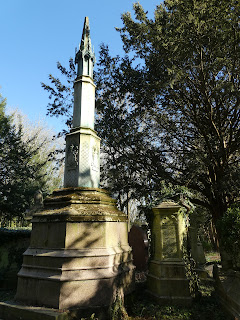The Highgate cemeteries are those rare things during lockdown - a destination that is open. And better still, "more" open than in normal circumstances. Normally the west cemetery can only visited by guided tour whereas currently you can go on your own, although pre-booked.
They are very keen to ensure they are complying with Government guidelines. So they say the cemeteries are open for "gentle exercise", but not for "recreation" or "tourism". Now, as a lawyer, I would love someone to define recreation in a way that excludes gentle exercise. I guess basically it means you can walk around provided you promise not to enjoy it. You also have to live in the area, without defining what the area is. I reckon than if I can walk to it, as someone nearing 60, it must be my local area.
Anyway, I decided to book a visit and had a very pleasant afternoon wandering around the two cemeteries, getting some gentle exercise - they are both on a sloping site up Highgate Hill.
The cemeteries were constructed in the 19th century with London's old burial grounds full. They fulfilled the Victorian taste for splendid and sentimental send offs. They were established for profit, aiming to attract a better class of corpse. They are still open to this day and there are a number of very recent famous burials, although they are now no longer run for profit. I think most of their income comes from entrance fees.
What makes the cemeteries so attractive to visit, ironically, is that they were left to decay for so much of the twentieth century, before being saved by the Friends of Highgate. Yes, it is interesting seeing the graves of the famous, but frankly there are not so many famous people here. Mostly it is the Victorian middle classes. No, what is so attractive is the way the old graves have become overwhelmed by the foliage and ivy and lichen, almost reclaimed by nature. It gives it all a gothic "Hammer House of Horror" feel.
Let's start with the East Cemetery. This one is normally open without pre-booking. It also probably contains the most famous graves, especially the newerones, with more interesting new types of gravestone. But still it is the older ones that just appeal the most...
And here is a fine example of changing fortunes and the fleeting nature of fame. While as noted above, Karl Marx could only attract 13 mourners, the chap buried in the grave below attracted a crowd of 10,000. But you are unlikely to have heard of Thomas Sayers. His fame was in being the top prize fighter of his day.
This is the Mausolem of Julius Beer, the most magnificent of all the mausoleums in the cemetery, built for the death of Beer's daughter, and based on the Mausoleum of Halicarnassus, one the Seven Wonders of the Ancient World.
This is the entrance to the Egyptian Avenue
The family repository of the artist Rossetti. The cemetery contains just over 50,000 graves but 170,000 people are buried here, many in family graves.

































































No comments:
Post a Comment